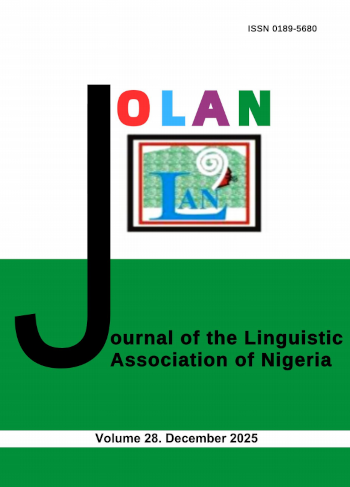A Semiotic Study of the Performance Rituals of Igede Dance Group: The Case of Aita Musical Ensemble
Keywords:
non-verbal signification, Igede and Aita dance groupAbstract
The paper is an analysis of the range of significations in the acts and materials of the aita dance group in Igede society. In Africa, people use different signification systems (verbal and non-verbal) to communicate meaning. Although some of the acts and materials cut across dance groups, and even cultures, the purpose and the interpretations attributed to them may differ. It is on this basis that the paper examines the semiotics of performance rituals of the aita musical ensemble in Igede society. To achieve this, the paper identifies, selects and interprets refreshment rituals during life performance in funeral ceremonies. Using Peirce’s theory of semiotics, the paper explains how parts of chicken and how they are shared among performers means more than just mere eating of meat to the group. The interpretation was aided by oral interviews held with some Igede elders versed in the area of Igede world view and culture. Explaining the effects of these rituals, the paper concludes that material communication is culture bound. It does mean that the phenomenon of signification is culture specific which largely depends on the world view of a group of people. The achievement of this paper is its ability to unveil the hidden meaning behind the acts and materials of musical groups in Igede society. It also shows that the act of sharing chicken as well as the parts of chicken can be utilized to perform communicative functions within the Igede culture. At large, the paper contributes to the study of non-verbal signification system.
References
Akan, S.S., Agbedo, C.U & Onukawa M. C. (2013) “Nonverbal Communication: The Semiotics of Facial Expression in Tiv.” In Nsukka Working Papers in Language, Linguistics and Literature. Vol. 1. 1&2 Pp 153-163
Alagh, E. I. (2017) “Use of artifacts in communication in Tiv” Journal of Llinguistic Association of Nigeria. Vol. 20. Pp. 28—35.
Chandler, D. (2014). Semiotics for Beginners. Retrieved October 27, 2019, from htt://www.visualmemory.co.uk/Daniel/documents/S4B/Semio.html
Eco, U. (1979). A Theory of Semiotics. Bloomington: Indiana University Press.
Hebert, L. (nd.). Elements of Semiotics. Retrieved October 27, 2019, from: htt://www.signosemio.com/elements-of-semiotics.asp.
Holman, R. H. (1980). “Clothing as Communication: An Empirical Investigation.” In NA-Advances in Consumer Research. Vol. 7, Jerry C. Olson & Ann Abor. MI:Association for Consumer Research, pp. 372-377.
Levy, S. J. (1959). “Symbol for Sale”. Harvard Business Review, 37, 117-124.
Lyons, J. (1981). Languages and Linguistics. Cambridge: Cambridge University Press.
Saussure, F. D. (1983). Course in General Linguistics. London: Duckworth.
Schneider, F. (2013). A Rough Guide to the Theory of Semiotics. Retrieved October 27, 2018, from: http://www.politicseastasia.com/wp-content/uploads/2013/07/character-ma400ₓ1276opt-jpg.
Robertson, T. S. (1970). Consumer Behavior. IL: Scott-Foresman & Co.
Rudrow K. J. (2014). Artifactual Communication: A Modern Approach to Understanding Through Nonverbal Artifacts. Undergraduate Research Journal for the Human Sciences. Vol 13.
Yina, G. (2011). Semiotics of Tiv Oral Poetry. Makurdi: Aboki Publishers. www.signsalad.com/our-thought/what-is-semiotics? Retrieved November 25, 2019














